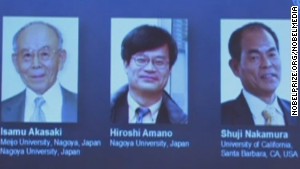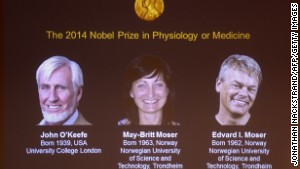- NEW: Committee head: "Guesswork has turned into hard facts and obscurity... into clarity"
- Eric Betzig, Stefan W. Hell and William E. Moerner share the Nobel Prize for chemistry
- Their work has shifted optical microscopy boundaries into the nanoworld
- Hell says he was "totally surprised" to receive the call that told him he'd won
(CNN) -- Two Americans and a German won the Nobel Prize in chemistry this year for their work on optical microscopy that has opened up our understanding of molecules by allowing us to see how they work close up.
The winners are Eric Betzig, Stefan W. Hell and William E. Moerner, the Nobel committee in Sweden announced Wednesday.
Back in 1873, science believed it had reached a limit in how much more of a detailed picture a microscope could provide. At the time, microscopist Ernst Abbe said the maximum resolution had been attained.
 2014 Nobel Prize in physics announced
2014 Nobel Prize in physics announced  Blue LED inventors win Nobel Prize
Blue LED inventors win Nobel Prize  2014 Nobel Prize in Medicine announced
2014 Nobel Prize in Medicine announced This year's winners proved that contention wrong.
Physics Nobel Prize goes to scientists who perfected LED light
"Due to their achievements, the optical microscope can now peer into the nanoworld," the committee said.
The importance can't be overemphasized: Now, scientists can see how proteins in fertilized eggs divide into embryos, or they can track proteins involved in Alzheimer's or Parkinson's diseases, the committee said.
Hell, of the Max Planck Institute for Biophysical Chemistry, Göttingen, and German Cancer Research Center, Heidelberg, both in Germany, developed a way to use two laser beams to make individual molecules glow on and off.
Speaking to the Nobel committee by phone after the prize was announced, Hell said the development of nanoscopy was "very important to life scientists" because the use of focused light is the only way to see how the body works at a cellular level.
He said he was "totally surprised" by the call from the Nobel committee and that it took a while for the news to sink in.
Betzig, of the Howard Hughes Medical Institute, in Ashburn, Virginia, and Moerner, of Stanford University in California, worked separately to develop the basis for single-molecule microscopy.
Medicine Nobel Prize goes for work on cells that form brain's GPS system
This uses light to make individual molecules glow and allows a dense super-image to be resolved at the nanolevel.
Committee chairman Sven Lidin said that thanks to their development of super-resolution fluorescence microscopy, cells could be studied close up and the boundary between chemistry and biology had blurred.
"Guesswork has turned into hard facts and obscurity has turned into clarity," he added.
Last year's prize in chemistry rewarded three scientists, Martin Karplus, Michael Levitt and Arieh Warshel, for work leading to the computer programs used today to predict the outcomes of very complex chemical reactions.
No comments:
Post a Comment